Pingg-String Ground Barrier (70m)
1-Wire or 3-Wire barrier to 50cm high.
Instant Solution Dog Electric Fence
Control your dogs without any training or special collars
Instant Solution Dog Electric Fence
Control your dogs without any training or special collars

Ground Barrier
The Pingg-String “Ground Barrier” (illustrated below) can be used to stop dogs damaging garden beds and keep dogs away from fences to stop digging under or climbing over.
The Ground Barrier may be installed at several locations in the garden. Sections are connected together using a special insulated cable. A single Pingg-String energiser can power many sections.
You can also construct a multi-wire barrier for small animals, such as cats and possums. The Pingg-String Ground Barrier is an effective solution to many animal problems!
The Pingg-String Ground Barrier is powered by the Pingg-String Solar Energiser (sold separately).
Get your Customised Fence Quotation:
Each Ground Barrier Kit contains:
- Thirty (30) fibreglass Support Posts (60cm long).
- Thirty (30) protective Post End Caps.
- One hundred (100 approx.) Pingg-String Wire Holders.
- One 70m (200ft) roll of Pingg-String Wire.
- One Ground Stake.
- One 10m (33ft) length of Insulated Cable.
Pingg-String Design Flexibility
Every installation is different which is why the Pingg-String can be ordered as components. Order your Pingg-String Energiser plus the fencing components you need.
When ordering this 70m Ground Barrier Kit, simply measure the total distance of the barrier you want to create and make sure you order enough 70m kits to cover that distance.
Note: One Pingg-String Energiser can power up to 400m (1350ft) of 1-Wire barrier, 140m (670ft) of 3-Wire barrier or 80m (260ft) of 5-Wire barrier. You can build bigger installations but you'll need additional energisers each powering its own separate section less than its maximum distance capacity.
The Pingg-String Ground Barrier System
Mini fence barrier demonstration
This illustration is a mini “Ground Barrier” using 3 wires through which we will demonstrate the sequence of installation. Typical installation is a single wire.
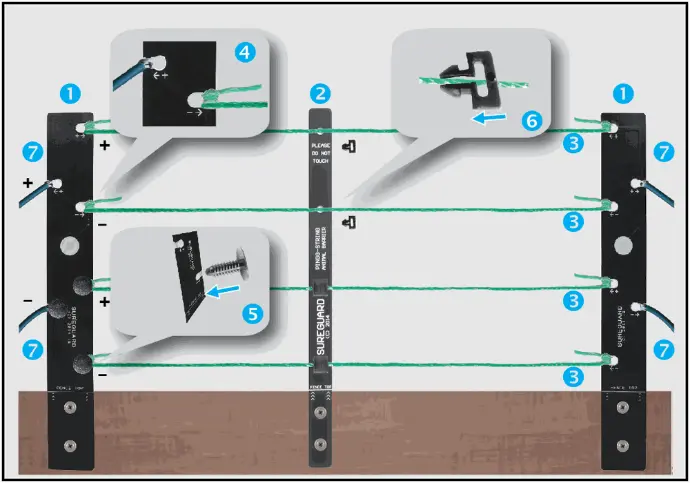
60cm long pushed 10cm into soil. If the soil is hard, soak to a depth of 10cm. If necessary you may use a mallet or hammer to insert the post into the soil but take care not to damage the end of the post. Space the posts 1m to 3m apart, closer for curves and longer for straights.
Slide onto the posts to keep the Pingg-Wire in place. One or more wire holders can be used and the heights are fully adjustable. Each wire holder has a groove where the Pingg-Wire is held. Only on the end posts is the Pingg-Wire tied. Otherwise wrap the Pingg-Wire 360 degrees around the groove and continue from post to post until the end post is reached.
Protect the exposed end of the fibreglass posts.
These are tied to a firm structure (eg. fence, building, etc) using builder’s string (or similar - not included). This will maintain tension in the Pingg-Wires. The illustration shows a secondary post being used as a tie-off anchor point.
Make electrical connections with insulated cable. The wires within the cable are tightly wrapping around the Pingg-Wire. Remove 3-4cm of insulation off the cable and twist it around the Pingg-Wire over a distance of 1-2cm.
Bury the 50cm Ground Stake 40cm deep into soil. Cut a length of insulated cable to go between the ground stake and the negative terminal of the Pingg-String Energiser. Remove 1cm of insulation from each end. For a 3-Wire fence cut a second length of cable to connect the negative Pingg-String Wire and the Ground Stake. Unscrew the terminal on the Ground Stake. Twist the wires together, place into the terminal and screw tight. Test that the cable(s) cannot be pulled out.
Connect the positive and negative of the fence to the corresponding red and green terminals of the Pingg-Energiser using lengths of insulated cable.
-
All Reviews 25 / 28 {'1': 0, '2': 0, '3': 0, '4': 4, '5': 24}Reviewed byJenni Beer00Ground barrierI was wanting to keep my cat out of my garden and this has worked a treat. Easy to install and so effective. Now my plants can grow in peace. If a leaf goes on the line it gives a little beep and you remove it. I had tried everything to keep the cat out, water, crystals, herbs, sprays, even mouse traps!! This is the only thing that has worked!! Thank youRead More9 years agoReviewed byJenny00SecurityWorks well for us with new pup to giver her a boundry with horses, sheep, cattle and goats on nearby property.Read More9 years agoReviewed byChristina Horne00Works for our two beagles- enough said?We moved into our home with a low fence on 3 of the 4 sides. Replacing it is a few years away but with two master tunnellers, jumpers, and runners, we needed a way to keep it secure. Pingg-String has been so far, undefeated. It’s kept our dogs safe and our new gardens safe as they establish. Perfect!Read More9 years agoReviewed byBenjamin Blunt00This product truly works wonders!Installed this device almost two months ago and it has kept our two beloved puppies away from our equally beloved garden bed. After a couple of harmless pings they both got the message and now take just one look at the wires and don't go anywhere near the raised garden bed. Prior to this they had started destroying plants and digging holes bringing tears to my eyes after all our hard work!Read More9 years agoReviewed byTM00Great productOne encounter with the Pingg string ground barrier and my foster puppy is no longer jumping the fence. She now actively avoids that area of the garden.Read More9 years agoReviewed byFranz Tuller00Pingg-String Ground Barrier SystemGreat system and easy to set-up. Suggest letting people know that when installing fibreglass posts that they wear gloves. When installing these posts, I had fibres in my hands for days and was extremely uncomfortable. Other than that, instructions good and system good. Dog doesn't like it though...lol.Read More9 years agoReviewed byRyan00Our front lawn is back!Our Rhodesian Ridgeback wees pure acid that no grass can withstand. As an added bonus she often proceeds to dig up each dead patch and leave a nice divot in the lawn for me to step in and twist a knee or ankle. Our front garden looked awful. I was at my wits end as I tried every idea from the forums, and nothing worked. And before you judge me, yes we walk her regularly! I then purchased the ping string with the solar energiser to keep both our dogs away from this area and I have had the system now for 4-5 months and it is brilliant. The grass has regrown and the kids have a place to kick a ball or do round offs. The dogs have a massive piece of grass behind the property to run and go nuts – funny they never even used to go there until the front became off limits. The Green String has now been identified as something not to be trifled with, so I now string it around garden beds and my trailer (yep the electrical wiring is catnip for our ridgie) -these strings aren’t even plugged in! So yes, I would highly recommend the ping string as a deterrent and retraining method – its sturdy and hasn’t given me an ounce of trouble since installing. One frustrating thing is I sometimes go too close with the whipper snipper which is a small price to pay for having our front garden back.Read More9 years agoReviewed byLaeth Harris00Ping String in - possums outEasy to setup, easy to use. Hopefully I might get some fruit this year - thanks!Read More9 years agoReviewed byLaeth Harris00No more shredded treesDoes exactly what it promises. Easy to setup and maintain. I might actually get some fruit this season!Read More9 years agoReviewed byIsabelle Dabrowski00Ping string ground fenceQuite a long process to install all the little poles which hold the wire. However after it is all done it is quite good. Dogs haven’t been in the pond since it has been installed.Read More9 years agoReviewed byNicole Larsen00Digging to visit neighbors dogWe have a border collie and a cattle dog that wanted to visit neighbors dogs in 1 day they dug a hole big enough to fit under the fence, trying to think of what we could do we came across suregard and gave it a go! It has been the best decision ever! Even though they still dig they will not go near the fence at all!!!! It took 1 attempt for them to never go near it! And now anytime they see any sort of wire they think it’s sure guard! I can now fence off plants with just wire, it’s an amazing product and would recommend to anyone worried about there dogs getting out!! IT DEFINITELY WORKSRead More9 years agoReviewed byLeo Hudson00An anxious Kelpie is tamedfDespite increasing the height of our suburban boundary fence to 1.8 metres Chief still scaled the fence and escaped placing himself at risk. After my purchase of the Pingg-String ground barrier with the solar energiser I installed it and invited him to have a sniff. Of course he received a bit of a jolt, and has refused to go near it for the past 6 weeks. This has consequently blocked his escape route and has been a great success.Read More9 years agoReviewed byCraig Skipper00Complete solutionWe tried many things before ping string and our dogs continued to run the fences, annoy us the neighbours and probably the whole street. Putting ping string near the fences has solved all of that and the dogs seem happier now too. This product has reduced the stress levels of so many people and most importantly our dogs.Read More9 years agoReviewed byIan Broadbent00no more digging under fencemy 2 dogs now wont go close to fence line and don't chase neighbours dog along fence. it also keeps them off garden Works perfectlyRead More9 years agoReviewed byGlenn Allen00Happy CustomerWas easy to set-up and worked straight away...a month on and still going strong.Read More9 years agoReviewed byMandy Raspin00Traumatised ChooksThe service was quick, the instructions easy to follow. Our dog was digging under the fence and getting into the next door neighbours chooks and destroyed our veggie garden. Since we have installed the Ping Sting he hasn't gone near the fence or the garden. I thin the neighbours might start talking to us again soon!!Read More9 years agoReviewed byAndrew Webber00Such a good thing.We are renting, and the timber fences are "soft" on two sides of our sizeable backyard. By "soft" I mean that they are very old, low, and not much of a barrier to a couple of curious, slightly diggy, dogs. When we viewed the house I suggested to my wife that I'd have to run an electric fence around the boundary... Six hours after we moved in, the beasts had already tested the boundaries, including a minor excavation of an area near the house, so I threw myself at Google. That's how I ended up with a ping-string. 45 minutes after getting the package in the mail my system was up and running. 47 minutes after getting the package in the mail one of the dogs was checking the boundary and touched the string... And that was that. No more digging at the boundary, and no fences leapt over. I think it is worth pointing out that I actually saw the interaction between my dog and the string -- it definitely startled him, but didn't seem to hurt him. All I care about, is that it worked. Great product. We hope to be buying in the next year or so, this system will be coming with us to the next house. Should take no more than 10 minutes to tear down, and will leave no trace that it was here in the first place. Dogs: Medium Middle Eastern Desert Multi-Breed-Mutts. Kind of jumpy, a little prone to digging. Installation: Exactly as described in the instructions.Read More9 years agoReviewed byLiz00Pingg String : 1 Beagle : Nil :-)I have waited to review this product to see if is still working after 6 weeks....it most definitely is. We were at our wits end with our Beagle for whom escaping had become a daily occurrence and a frequent lark. She was competent at going under, over, and through whatever fences we put in her way. She digs, climbs and jumps clear over wire and timber fences from farm fencing to picket fences around the house. The Pingg String is the first barrier that has worked effectively, and consistently, and she no longer challenges the fence-line at all. I would highly recommend this for use to prevent dogs going through an existing fence. The wire is barely noticeable as you look around our garden and didn't work as a stand-alone fence for us, but along a physical barrier it is perfect. Thank you Sureguard for your excellent advice and recommendation regarding installation, and I wish I'd tried this product years ago!Read More9 years agoReviewed byWilliam Dent00Pingg String BarrierWe are delighted with the Pingg String Ground Barrier. We needed a solution to stop our cat getting from our verandas to the neighbouring apartments via common garden beds. As we couldn't keep our apartment closed up, particularly over summer, we wanted something effective and unobtrusive that allowed us to keep our doors open. After we installed the barrier and hooked up the energisers, the cat had one unsuccessful attempt to get through. It has not tried again and the Pingg String has proven to be a most effective barrier. We highly recommend it.Read More9 years agoReviewed byMandy00The order arrived very quickly. It was...The order arrived very quickly. It was easy to set up and has worked really well at keeping my dog away from my neighbour's chickens.Read More9 years agoReviewed byJm00Excellent service. From the first...Excellent service. From the first enquiry to a couple of very helpful follow up phone calls. We also appreciated the pre-completed order form which avoided any confusion on our part. Made things very simple. Very pleased with the pingg string. Worked really well - and very, very quickly. No more problems!Read More9 years agoReviewed byCraig W00We purchased a ping string system years...We purchased a ping string system years ago and it still works very well and is amazingly effective at protecting our garden. We recently moved house and wanted additional areas protected. We considered the collar systems but decided to go with the ping string - and are very pleased we did . The new system is an improvement on the old - especially the new wire itself. The service and delivery has been faultless both times.Read More9 years agoReviewed byLisa00Service was excellent. Fence is working...Service was excellent. Fence is working really well in stopping our dog digging under our fence.Read More9 years agoReviewed bySue00Excellent service, fast delivery and...Excellent service, fast delivery and very helpful when we called for assistanceRead More9 years agoReviewed byFelix Farrugia00Prompt delivery, stopped our dog from...Prompt delivery, stopped our dog from digging up the plants and garden. Would recommend suregard to help with saving our gardenRead More9 years ago
Write your review
You must be logged in to post a review.
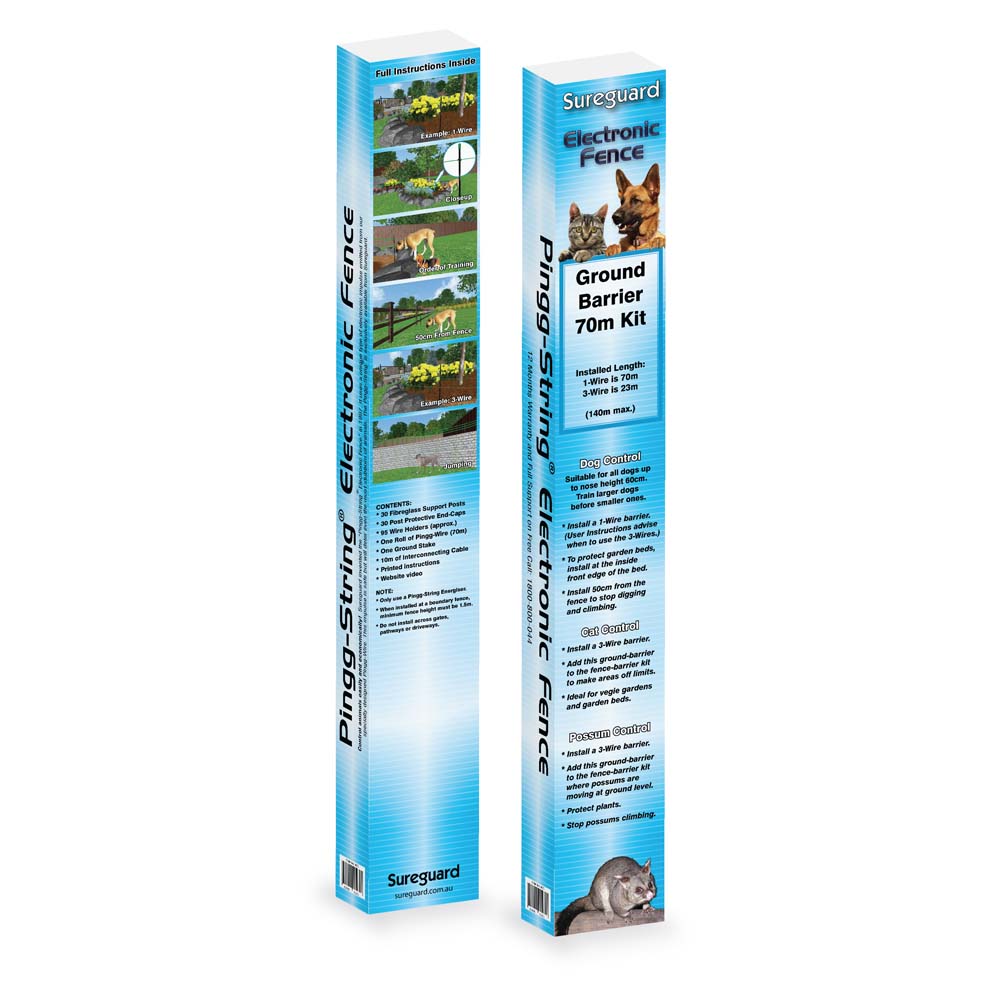
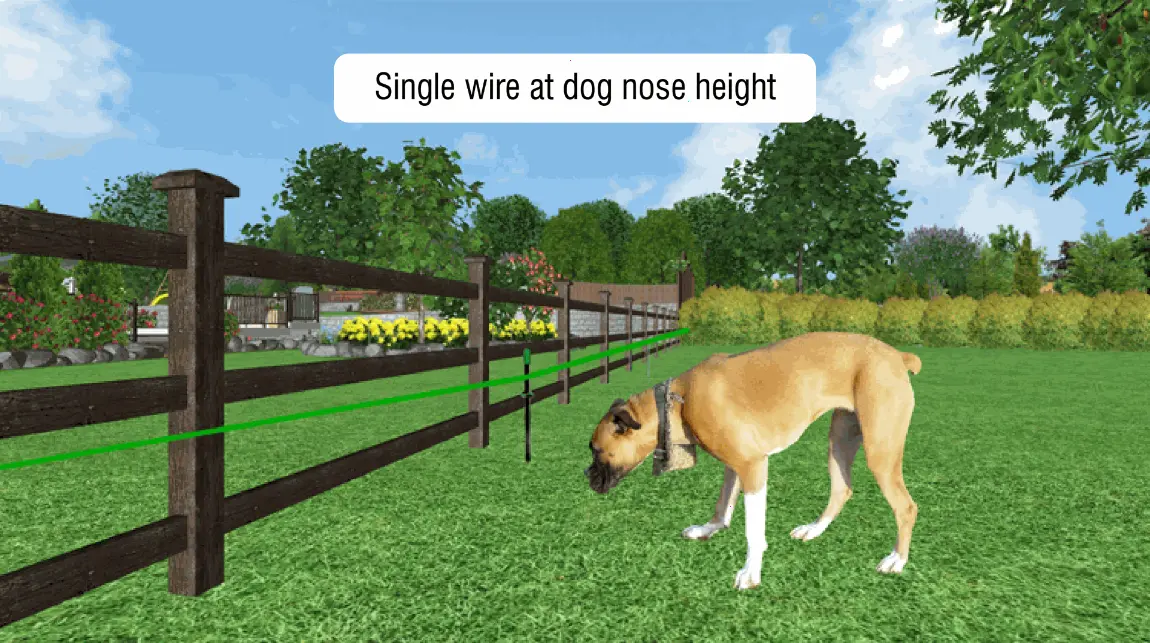

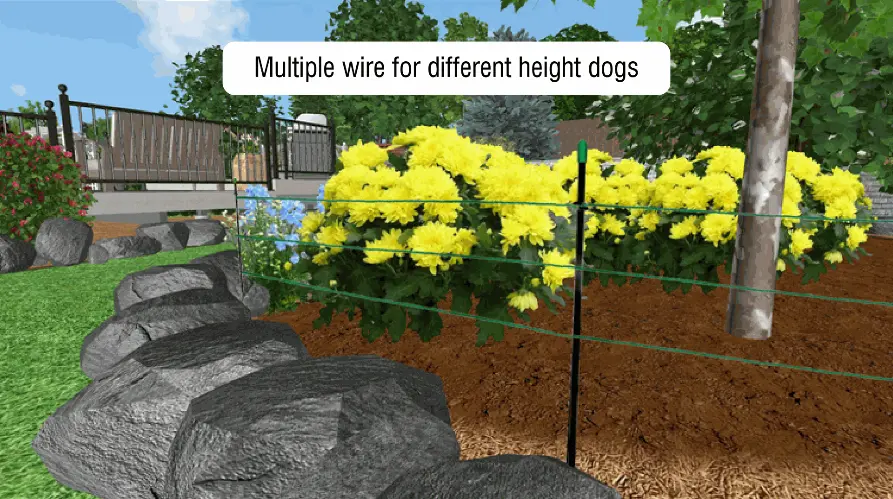
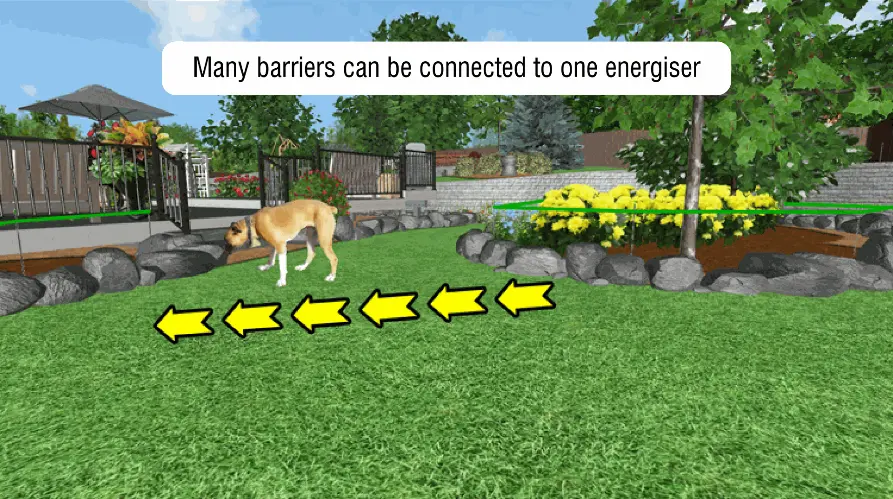
 Download Pingg-String Installation Guide
Download Pingg-String Installation Guide























